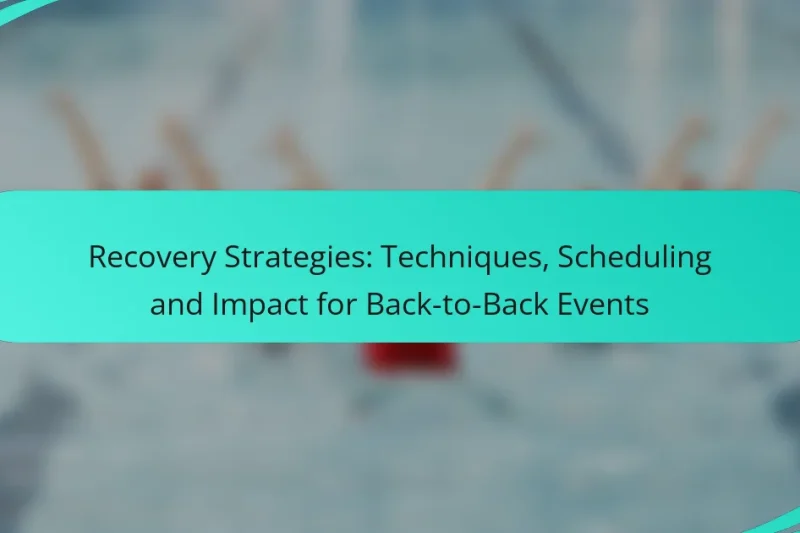Nutrition is essential for Olympic weightlifters, significantly impacting their energy levels, muscle recovery, and overall performance. … Nutrition: Impact, Strategies and Best Practices for Olympic WeightliftersRead more
Olympic Training Methodologies: Recovery Protocols
Olympic training methodologies emphasize the importance of effective recovery protocols to enhance physical recovery, prevent injuries, and boost overall performance. Tailored to the specific demands of various sports, these protocols incorporate active recovery techniques, hydration strategies, nutrition plans, and sleep optimization. Additionally, advancements in technology provide athletes with valuable tools to monitor their recovery processes and make informed decisions for optimal performance.
Active vs Passive Recovery: Techniques, Benefits and Applications
Active and passive recovery are two distinct approaches to post-exercise recuperation, each offering unique benefits. Active … Active vs Passive Recovery: Techniques, Benefits and ApplicationsRead more
Recovery Days: Implementation, Scheduling and Benefits in Olympic Training
Recovery days play a vital role in Olympic training, serving to optimize performance and minimize the … Recovery Days: Implementation, Scheduling and Benefits in Olympic TrainingRead more
Recovery Strategies: Techniques, Scheduling and Impact for Back-to-Back Events
Recovery strategies for back-to-back events are essential for maintaining peak performance and overall well-being. By integrating … Recovery Strategies: Techniques, Scheduling and Impact for Back-to-Back EventsRead more
Massage Therapy: Effectiveness, Techniques and Benefits for Olympic Athletes
Massage therapy plays a crucial role in the training and recovery of Olympic athletes, offering numerous … Massage Therapy: Effectiveness, Techniques and Benefits for Olympic AthletesRead more
Sleep: Importance, Impact and Strategies for Olympic Swimmers
Sleep plays a crucial role in the performance of Olympic swimmers, as it enhances recovery, sharpens … Sleep: Importance, Impact and Strategies for Olympic SwimmersRead more
What are the best recovery protocols for Olympic athletes?
The best recovery protocols for Olympic athletes focus on enhancing physical recovery, preventing injuries, and improving overall performance. These protocols typically include active recovery techniques, hydration strategies, nutrition plans, sleep optimization, and cold therapy methods.
Active recovery techniques
Active recovery techniques involve low-intensity exercises that promote blood flow and reduce muscle soreness. Activities such as light jogging, cycling, or swimming can help facilitate recovery without placing additional strain on the body.
Incorporating dynamic stretching and mobility exercises can also aid in recovery by improving flexibility and reducing stiffness. Athletes should aim for 20-30 minutes of active recovery sessions after intense training or competition.
Hydration strategies
Proper hydration is crucial for recovery, as it helps maintain optimal physiological functions. Athletes should monitor their fluid intake, aiming for at least 2-3 liters of water daily, adjusting based on sweat loss during training.
Electrolyte-rich beverages can be beneficial post-exercise, especially after prolonged or intense workouts. Consuming drinks containing sodium and potassium can help replenish lost minerals and support recovery.
Nutrition plans
A well-structured nutrition plan is essential for recovery, focusing on macronutrient balance. Athletes should consume a mix of carbohydrates, proteins, and healthy fats within 30-60 minutes post-exercise to optimize muscle repair and glycogen replenishment.
Incorporating whole foods like lean meats, whole grains, fruits, and vegetables ensures athletes receive necessary vitamins and minerals. Aiming for a protein intake of around 1.2-2.0 grams per kilogram of body weight can support muscle recovery.
Sleep optimization
Sleep plays a vital role in recovery, with most athletes requiring 7-9 hours of quality sleep each night. Prioritizing sleep hygiene, such as maintaining a consistent sleep schedule and creating a comfortable sleep environment, can enhance recovery outcomes.
Incorporating relaxation techniques like meditation or deep breathing before bedtime can improve sleep quality. Athletes should avoid stimulants and screens close to bedtime to promote better rest.
Cold therapy methods
Cold therapy methods, such as ice baths or cryotherapy, are commonly used to reduce inflammation and muscle soreness post-exercise. These methods can help constrict blood vessels, decreasing metabolic activity and swelling.
For effective use, athletes can apply cold therapy for 10-15 minutes immediately after intense workouts. However, it’s essential to balance cold therapy with other recovery methods to avoid potential negative effects on muscle adaptation.
How do different sports influence recovery protocols?
Different sports require tailored recovery protocols due to their unique physical demands and injury risks. For instance, high-impact sports may focus more on joint recovery, while endurance sports emphasize muscle repair and hydration.
Athletics recovery practices
Athletics recovery practices often include a combination of active recovery, stretching, and nutrition. Athletes typically engage in light jogging or dynamic stretching to promote blood flow and reduce muscle stiffness after intense training sessions.
Nutrition plays a critical role, with a focus on protein intake to aid muscle repair and carbohydrates to replenish glycogen stores. A common guideline is to consume a recovery meal within 30 to 60 minutes post-exercise.
Swimming recovery strategies
Swimming recovery strategies emphasize low-impact activities and hydration. Swimmers often use techniques like foam rolling and gentle swimming to alleviate soreness and maintain flexibility without stressing the body.
Hydration is crucial, as swimmers can easily underestimate fluid loss. Incorporating electrolyte-rich drinks can help restore balance, especially after long training sessions or competitions.
Cycling recovery techniques
Cycling recovery techniques focus on both active recovery rides and nutrition. Cyclists often perform low-intensity rides to promote circulation and help clear lactic acid from their muscles.
Post-ride nutrition is vital, with recommendations for a 3:1 ratio of carbohydrates to protein to optimize recovery. Cyclists should aim to consume this within an hour after their ride to maximize benefits.
What role does technology play in recovery?
Technology plays a crucial role in recovery by providing athletes with tools and data to optimize their recovery protocols. These innovations help monitor physiological responses, track progress, and enhance overall performance through informed decision-making.
Wearable recovery devices
Wearable recovery devices, such as heart rate monitors and sleep trackers, offer real-time insights into an athlete’s recovery status. These devices can measure metrics like heart rate variability and sleep quality, which are essential for assessing recovery needs.
When selecting wearable devices, consider factors like battery life, comfort, and compatibility with other training tools. Popular options include the WHOOP strap and Oura ring, which provide detailed analytics to help athletes adjust their recovery strategies effectively.
Recovery apps and platforms
Recovery apps and platforms centralize data from various sources, allowing athletes to monitor their recovery in one place. These applications often include features like guided recovery routines, nutrition tracking, and personalized feedback based on user data.
Examples of effective recovery apps include TrainHeroic and MyFitnessPal. When using these platforms, ensure that the app integrates well with your existing devices and provides actionable insights tailored to your specific recovery goals.
Virtual coaching for recovery
Virtual coaching for recovery connects athletes with experts who can provide personalized guidance and support remotely. This approach allows for tailored recovery plans that consider individual needs, preferences, and progress.
Coaching platforms like BetterUp or CoachAccountable can facilitate communication and feedback. When engaging with virtual coaches, prioritize those with experience in sports recovery to ensure they understand the unique demands of athletic performance and recovery.
What are the psychological aspects of recovery?
The psychological aspects of recovery involve mental processes that help athletes restore their focus, motivation, and emotional stability after intense training or competition. Effective recovery goes beyond physical rest, incorporating techniques that address mental fatigue and stress management.
Mental recovery techniques
Mental recovery techniques are strategies designed to help athletes clear their minds and regain mental energy. Techniques such as visualization, where athletes imagine successful performances, can enhance confidence and reduce anxiety. Additionally, journaling about training experiences and emotions can provide insights and foster a positive mindset.
Another effective method is engaging in light, enjoyable activities unrelated to sport, which can help shift focus and alleviate stress. Athletes should aim to incorporate these techniques regularly, especially after high-pressure events, to maintain optimal mental health.
Mindfulness practices
Mindfulness practices involve being present and fully engaged in the moment, which can significantly aid recovery. Techniques such as meditation and deep-breathing exercises help reduce stress hormones and improve emotional regulation. Athletes can start with just a few minutes of focused breathing each day to cultivate this skill.
Incorporating mindfulness into daily routines can enhance resilience and mental clarity. For example, athletes might practice mindful walking or stretching, paying attention to their movements and sensations. Consistent practice can lead to improved focus during training and competition, ultimately supporting better performance outcomes.
How can recovery protocols be tailored for individual athletes?
Recovery protocols can be customized based on an athlete’s unique needs, training intensity, and physical condition. Tailoring these protocols involves assessing individual recovery times, preferences, and any specific injuries or conditions that may affect recovery.
Personalized recovery plans
Personalized recovery plans focus on the specific requirements of each athlete, taking into account their sport, training load, and personal recovery preferences. Factors such as age, fitness level, and injury history should also be considered to create an effective plan.
For example, a sprinter may benefit from active recovery techniques like light jogging or cycling, while a weightlifter might require more passive recovery methods such as stretching or foam rolling. Incorporating a variety of recovery modalities can enhance overall effectiveness.
To develop a personalized recovery plan, athletes should monitor their response to different recovery strategies, adjusting as necessary. Common elements to include are hydration, nutrition, sleep quality, and specific recovery techniques like ice baths or massage therapy.





